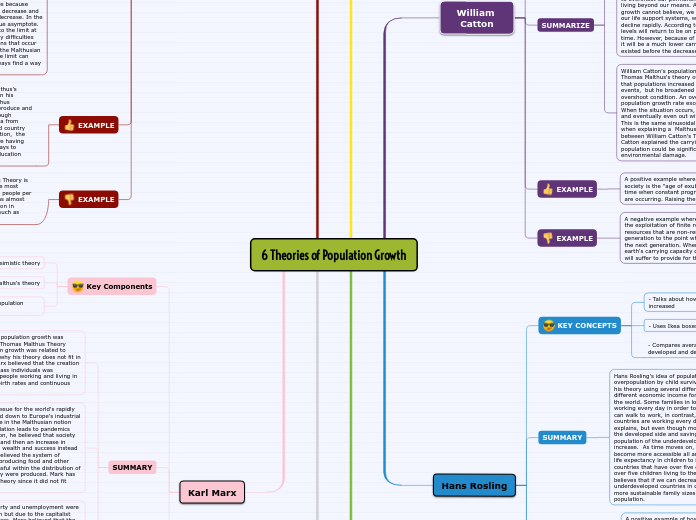6 Theories of Population Growth
Don Bogue
Key Concepts
SUMMARY
EXAMPLES
An example of a positive way Bogue's theory is applied to society is Bogue's theory suggests that counties and nations can avoid overpopulation by their own means by advancing in technology or contraceptive measures.
An example of a negative way Bogue's theory can be applied to society is that if a nation can not avoid reaching overpopulation Bogue's theory suggests the nation will reach an inevitable malthusian peak. Malthusian peaks as explained before are the idea that nature takes it course and natural disasters/famine strike a nation when it is overpopulated.
Quotations
"Because of the combined action of these forces, it may be supposed that the efficiency and degree of success with which a population can realize its ideals in practice are much greater today than ever before and will increase even more as further advances are made in contraceptive technology and experience in its use. Within our lifetime we may see fertility control become an integral part of the morals and culture, with highly developed social organizations for maintainlng it, in all societies of the world. In other words, the theory of demographic regulation is a positive assertion that nations, when faced with serious overpopulation, will undergo adaptive social change to lower fertility rates and in so doing will invent and adopt a technology of contraception. Moreover, this theory asserts that modern man is able to foresee demographic catastrophe long before it arrives and takes adaptive action long before it is forced on him by the brute forces of nature."
D. Bogue. 1969. Principles of Demography.
William Catton
Key Concepts
- Pessimistic theory
- William Catton explains carrying capacity as the maximum lastingly sustainable population that can be maintained within society. It is the number of people within a given ecosystem that can be held continually. In a sustainable economic society, carrying capacity is not surpassed.
- The phantom carrying capacity is when a population is utilizing non-renewable resources that support the current generation within society but will be overused to the point that there will not be enough for the next generation to survive.
SUMMARIZE
William Catton has a new view on population growth. To explain his theory, Catton starts with a factual outlook. Catton believes that the overpopulation Crisis began in the sixteenth and seventeenth centuries. He refers to this time as the "age of exuberance." According to Catton, the age of exuberance was a time where there was tremendous progress in Revolution within Society. Due to the progress and Revolution, the earth's carrying capacity grew. During the Industrial Revolution, the earth's carrying capacity went through. Of the time of even more growth, the Industrial Revolution caused the use of non-reusable resources, Catton refers to these resources as finite resources. Catton believes that these resources are exploited by one generation and then needed but unavailable to the next generation. According to Catton's theory, the industrialization and technology that have helped us develop a phantom carrying capacity will cause us to overshoot our permanent carrying capacity since we are living beyond our means. After these increases in population growth cannot believe, we will suffer from severe failures in our life support systems, which will cause the population to decline rapidly. According to Catton's Theory, the population levels will return to be on par with the carrying capacity over time. However, because of the damage done environmentally, it will be a much lower carrying capacity than the one that existed before the decrease began.
William Catton's population growth theory had the same ideas Thomas Malthus's theory of population growth he believed that populations increased and decreased due to natural events, but he broadened his approach by explaining an overshoot condition. An overshoot condition occurs when the population growth rate exceeds the planet's carrying capacity. When the situation occurs, a population will start to decrease and eventually even out with a carrying capacity once again. This is the same sinusoidal graph that Thomas Malthus used when explaining a Malthusian point. The main difference between William Catton's Theory And Malthus's theory is that Catton explained the carrying capacity of the earth's population could be significantly decreased due to the planet's environmental damage.
EXAMPLE
A positive example where Catton's theory can be applied to society is the "age of exuberance". The age of exuberance is a time when constant progress is being made and revolutions are occurring. Raising the carrying capacity of the earth.
EXAMPLE
A negative example where Catton's theory can be applied is the exploitation of finite resources. Finite resources are resources that are non-renewable and exploited by one generation to the point where there is not enough to support the next generation. When finite resources are overused, the earth's carrying capacity decreases since the future generation will suffer to provide for themselves.
Hans Rosling
KEY CONCEPTS
- Talks about how world population have progressed and increased
- Uses Ikea boxes to help convey his ideas
- Compares average families shopping wants in the under developed and developed world
SUMMARY
Hans Rosling's idea of population growth is that we can stop overpopulation by child survival. Furthermore, he explained his theory using several different boxes. Each box represents a different economic income for families in different places of the world. Some families in lower developed countries are working every day in order to buy a pair of shoes so that they can walk to work, in contrast, other families in developed countries are working every day in order to buy a car. Hans explains, but even though more countries are moving towards the developed side and saving up to buy cars, the world population of the underdeveloped side is continuing to increase. As time moves on, vaccines and healthcare will become more accessible all around the world, resulting in the life expectancy in children to increase. The underdeveloped countries that have over five children per mother we will see over five children living to the next generation. Rosling believes that if we can decrease the economic gap between underdeveloped countries in developed countries, we will see more sustainable family sizes and a sustainable world population.

Link to Hans Rosling's TED talk
https://vlozanor5088.wixsite.com/6populationtheories
EXAMPLE
A positive example of how Hans Rosling's theory can be applied to population growth is the idea of more countries economies progressing to a level where families are striving to buy cars. In Rosling's Ted Talk, he addresses the idea that over time more and more countries' economic levels will Progress to a point where the countries that were striving to buy bicycles will soon be striving to buy cars. An example of how this idea can cause positive population growth would be is globally it developed countries could find a way to mend the gap between the underdeveloped countries and themselves in order to make the global population be striving towards buying cars. "Buying cars" is a figurative way to explain that it would end poverty, and the whole world would be living in the same living standards.
EXAMPLE
A negative example of how Rosling's Theory can be applied to population growth will be if we do not mend the gap between underdeveloped countries and developed countries. Underdeveloped countries' populations will continue to double until they reach an unsustainable point for the earth's carrying capacity. Meanwhile, while this is occurring, the countries striving to buy bicycles will move into an economic state striving to buy cars, resulting in a surplus of the population being in poverty and overall overpopulation on earth.
Julian Simon
KEY CONCEPTS
- Optimistic theory
- “Reasource scarcity increases the cost of a product, thus creating incentive to find alternative materials”
Simon. J. 1980. "The Ultimate Resource"
- Economic approach
SUMMARY
Julian Simon was a university professor in the 1980s. Julian's theory of population growth approach to population growth from an economic perspective. During the time Julian Simon proposed his theory, it was believed that the earth would come to a point where they would run out of resources, and the world population would starve hunger. In other words, it was massively believed that the world population was doomed. Simon opposed this theory and believed that the world population was not doomed. Julian wrote a book on population growth called "the ultimate resource," where he explained the ideology that when resources start to diminish, it increases the cost of the resource. When this happens, people tend to try and find different resources that will perform the same task. To put Simon ideas into context, he believed there was no way for the world population to run out of resources and starve hunger because the world population would just keep finding new resources to use, as well as recycling the old resources and coming up with innovative solutions. Julien Simon argued that even though some materials were finite, economically, materials are indefinite. Julien Simon believed that the human population has been increasing for the past forty thousand years or so, and has not run out of resources. There is no way the human population will run out of resources or not find a way to solve a problem of lack of resources in the future.
EXAMPLE
A common material that we use, such as wood, could become scarce, increasing the price of wood as wood becomes less and less affordable population start to look for something else to use instead of wood that they can afford. Since a new resource has replaced the wood, the wood price goes down once again.
Thomas Malthus
KEY COMPONENTS
- Pessimistic theory
- “The power of population is so superior to the power of the Earth to produce subsistence for man, that premature death must in some shape or other visit the human race. The vices of mankind are active and able ministers of depopulation. They are precursors in the great army of destruction, and often finish the dreadful work themselves. But should they fail in this war of extermination, sickly seasons, epidemics, pestilence, and plague advance in terrific array, and sweep off their thousands and tens of thousands. Should success be still incomplete, gigantic inevitable famine stalks in the rear, and with one mighty blow levels the population with the food of the world”.
Malthus T.R. 1798. An essay on the principle of population. Chapter VII, p61
- Most prominent theory
SUMMARY
This quotation gives a general sense of how Thomas Malthus viewed population and population growth. Thomas Malthus was from the 1700s and lived in a society where people were very optimistic about progress and the idea of progressing as a nation. However, despite the opinions around him, Thomas Malthus how to view the point that If people can increase the population, they will. He believes that if people had enough food in time, they would reproduce and grow the population. The problem Thomas Malthus saw with this was that he believed that it would increase to a number so significant that we could no longer support ourselves with the resources available to us. In Thomas Malthus, his opinion once a population has reached the over bound and can no longer support itself. The "Vices" of the Earth Will show up and cause a depopulation. If, however, the vices of the earth do not show up, then like Thomas says in his quotation, war, pandemics, famine, and sickness will be the cause of the population. To put this Theory into context, a population can have an excellent crop to provide food for everyone as well as money on the table to provide for families and the economy. However, a population could also have a bad crop and end up with no food, which results in a famine or little food available for the population, resulting in the war over resources. Thomas Malthus' main idea was that population oscillates because sometimes it will increase and sometimes it will decrease and usually when it has hit an increase after it will decrease. In the graphs I have depicted above, you can see a blue asymptote. The blue asymptote is meant to be a guideline to the limit at which a population can reach without having any difficulties with the resources available to it. The oscillations that occur amongst this line are sometimes referred to as the Malthusian limit. Thomas also took note of the fact that the limit can increase over time, but that populations will always find a way to reach it.

Link to Graphics:
https://vlozanor5088.wixsite.com/6populationtheories
EXAMPLE
A Positive example that can come from Thomas Malthus's theory is that not everything Thomas Malthus said in his theory is 100% correct. For example, Thomas Malthus believed that if people had the time, they would reproduce and populate the world. However, as we have seen through modern society, this is not exactly true. Recent data from countries around the world shows that if society and country reaches a stable enough position financially as a nation, the people who populate that country will hold off before having children or not have children at all and find other ways to spend their time, for example, furthering in their education and occupation.
EXAMPLE
A negative example that can help confirm Thomas's Theory is a country like Bangladesh. Bangladesh is one of the most populated countries in the world and has about 900 people per square foot. This is an example of a country that has almost reached its Malthusian limit. Due to its overpopulation in relatively fertile land, it has had several problems, such as famine and natural disasters, such as floods.
Karl Marx
Key Components
- Pessimistic theory
- does not agree with Thomas Malthus's theory
- Karl Marx does not have a defined theory on population growth but he wrote about population
SUMMARY
Karl Marx did not believe that the population growth was controlled by any natural law like Thomas Malthus Theory suggested. He believed population growth was related to 19th-century capitalism, which is why his theory does not fit in well with today's social norms. Marx believed that the creation of a surplus population of lower-class individuals was necessary. In order to keep most people working and living in poverty, which will result in high birth rates and continuous labour surplus.
Karl Marx believed that the main issue for the world's rapidly growing population could be traced down to Europe's industrial societies. Karl Marx did not believe in the Malthusian notion that the rising of the earth's population leads to pandemics and illnesses. In Karl Marx's opinion, he believed that society had good order and organization, and then an increase in population would cause enormous wealth and success instead of hunger and misery. Karl Marx believed the system of capitalism would have success in producing food and other necessities but would be unsuccessful within the distribution of social and economic well after they were produced. Mark has wholly rejected Thomas Malthus Theory since it did not fit within a socialist society.
Based on Karl Marx's theory, poverty and unemployment were not due to an increased population but due to the capitalist system that exploited the lower class. Marx believed that the surplus of population was the consequence of production and uneven distribution of well-providing jobs to only a few people within society. According to Marx, there was no country on earth where the population increased on account of fertility, but it only increased on account of capitalist policies. Due to the increase in population, the bourgeoisie, which is a word used to describe the upper class, would exploit the working class by reducing wages so that they would live in poverty. Mark stated that because of the capitalist system failing to provide jobs with good wages, poverty and unemployment would increase. The increase in high rates of poverty results in high birth rates because of the low living standards.
EXAMPLE
To put Karl Marx's Theory into perspective here is an example, a factory worker is given less wage than the value of his productivity. Resulting in the factory worker living in low standards. The worker needs to have several children to help him provide for his family. Thus causing an increase in population. When machines are introduced to the factory, unemployment levels within the factory increase as employees are needed less since machines are doing more work. When these situations occur, the rate of pay goes down further, causing employees who already had low wages to have even lower wages. Therefore, a surplus of the population belongs to the lower class. The bourgeoisie is the part of the population that owns the factories and pays the factory workers. They could also be considered the upper class. Only a few individuals are part of this upper class. According to Karl Marx, poverty, hunger and other sicknesses are the results of unjust capitalism social practices.
BY: VAL LOZANO
Thanks!
